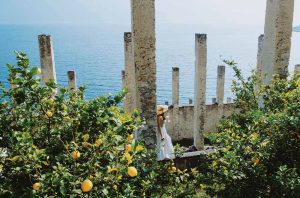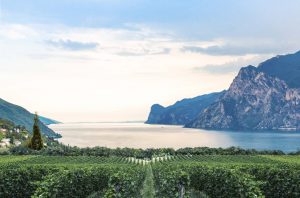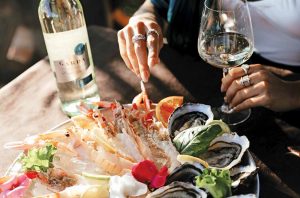A ‘piece of the Mediterranean’ at the foot of the Alps: a snapshot that captures the essence of the Garda DOC area around Italy’s largest lake. The climate, though temperate, evokes Italy’s Mediterranean shores, as the vines are caressed by lake breezes, and enjoy extra sunshine courtesy of the mirror-like waters. This is a place that touches the soul and remains forever imprinted in the memory of those who experience its beautiful landscapes, its lush Mediterranean flora (lemon and olive trees, caper bushes and cedars), its art, architecture and history, and its local food and wine. Established in 1996, the Garda DOC embraces ten historic appellations across two regions, Veneto and Lombardy, and includes world-famous wines such as Bardolino, Valpolicella, Soave and Lugana.

Glittering waters
The effervescence of Garda’s sparkling wines seems to express the waters’ own sparkle, as well as the viticultural potential of its lands and the savoir-faire of its people. Cesare Ferrari, an expert winemaker, believes that the lake’s climate, moderating breezes and temperature variation are what bring out the best from Chardonnay and Pinot Noir, especially in traditional method sparkling wines.
Garda DOC ‘Metodo Classico’ is mainly produced in Lombardy, to the west of the DOC, where it has been made for over 50 years, while the Charmat method version is more common in the Veneto region to the east – such as in Soave and Custoza. The grapes used also vary: the white traditional method sparkling is based on Chardonnay and Pinot Noir/Nero with small amounts of Turbiana (Trebbiano di Lugana), while the rosé uses Corvina, Rondinella, Groppello and Pinot Noir. Of the Charmat method sparkling, the white uses Garganega with additions of Chardonnay and Pinot Grigio, while the rosé is based on Pinot Noir, Marzemino and Merlot.
The Charmat method sparkling spends up to six months in the autoclave on the lees, while for the traditional method wines – which are mostly brut – time sur lattes ranges from 15 to 36 months, with some outliers going up to six years. Garda DOC’s sparkling wine sector is enjoying enormous growth: in the past seven years, annual production has increased from 57,000 bottles to 774,000, and is forecast to continue its upward trend.

A perfect match
Garda’s sparkling wines make a perfect start to a meal, especially in view of their lower alcohol content – but their freshness, charm and versatility also makes them a popular choice to accompany a variety of dishes. Giampietro Ferri, the owner and sommelier of a historic restaurant in the province of Mantua, has noticed how customers’ curiosity is particularly piqued by local sparkling wines, which are both an expression of the territory and evocative of the area’s natural beauty.
Ferri suggests serving Garda sparkling wine with local charcuterie or lightly marinated lake fish: ‘Our cuisine comes from the land and the lake, and we see that the combination works very well.’ For first courses, he recommends trout-filled agnolotti pasta, whitefish risotto and spaghetti with lake sardines. ‘Other great food and wine pairings include Garda fish such as sturgeon, pike, sardines, trout, carpione (a rare delicacy found only in Lake Garda) and eel – a fatty texture that the wine offsets with its freshness,’ Ferri continued.

Of course, Garda DOC sparkling always tastes best served alongside fresh local fish, on the shores of the lake itself! Coming to explore this unique area, you’ll find exceptional restaurants and authentic trattorias overlooking the lake that are sure to leave you with an experience to remember.
![]()
Garda DOC – Five wines to try:

Perla del Garda, Metodo Classico Extra Brut (90 pts)
For 17 years, Giovanna Prandini has managed her family’s 40 hectares of vineyards. The 20-year-old vines of this pure Chardonnay (24 months on the lees) grow on limestone-clay soils. On the nose, aromas of pear, hazelnut and honeysuckle. Silky in the mouth, the texture is fluid and vibrant to the finish.
www.perladelgarda.it

Borgo la Caccia, Kames, Metodo Classico Rosé (90 pts)
This non-profit cooperative, chaired by Andrea Bonomelli, employs people with addiction problems. Wine is their pride and joy. Guided by winemaker Stefano Chioccioli, they produce a creamy rosé from Pinot Noir, 27 months on the lees. Aromas of red fruits and hazelnut; a fine, elegant texture and lengthy, savoury momentum.
www.borgolacaccia.it

Azienda Agricola Prendina, Cuvée Maison, Metodo Classico Brut (90 pts)
The Piona family acquired the estate in 1958, and first bottled in 1980. The 42 ha of vineyards grow on limestone, clay and sandy soils. A 90% Chardonnay, 10% Corvina blend, aged for 24 months on the lees. Hints of lime, aromatic herbs and graphite; compelling rhythm on the palate with vivid tension to the end. www.tenutedifamiglia.com/it/prendina

Baroldi Diego, Metodo Classico Extra Brut (88 pts)
Founded in 2015 by winemaker Diego Baroldi, the winery has 3 ha of vineyards on moraine and sandy-clay soils in Cavriana, near Mantua. A fine perlage for this pure Chardonnay, 18 months on the lees. Notes of white plum, linden and aromatic herbs. Dynamic progression, freshness and vigour on the palate.
www.agricolabaroldidiego.it

Zenato, Metodo Charmat Brut Rosé (87 pts)
Alberto and Nadia Zenato continue the pioneering work of their father, Sergio, who founded the company in the 1960s. A rosé (65% Merlot, 35% Pinot Noir) from 15-year-old vines on clay soils in Peschiera del Garda near Verona. Red fruits, cherry and citrus on the nose – balanced and full of vitality with a long finish.
www.zenato.it
Discover more about Garda DOC
Connect on
Facebook | Instagram








